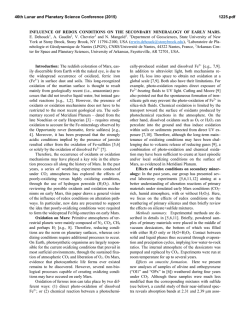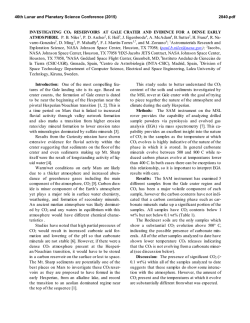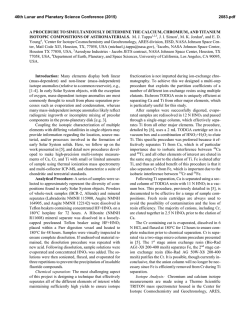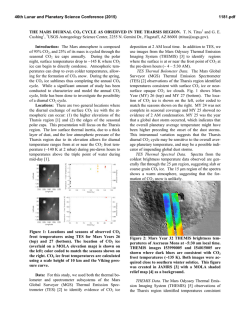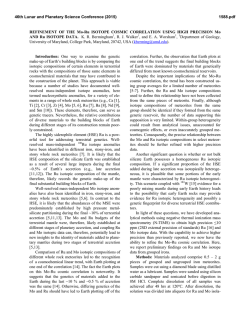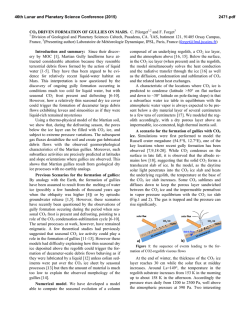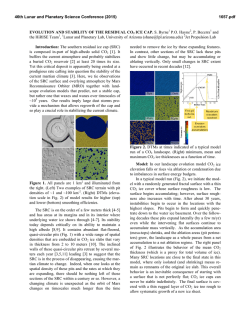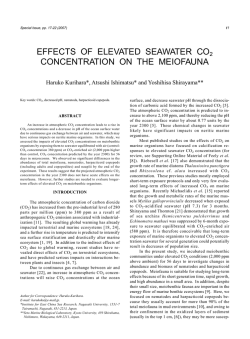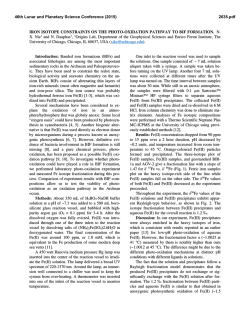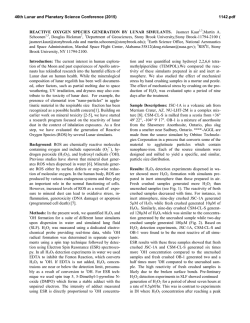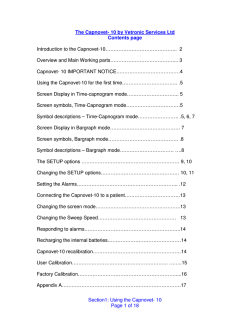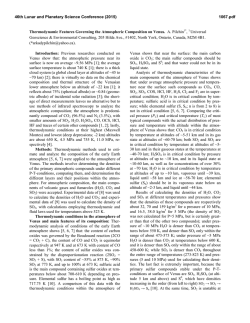
Carbon Isotopes of Evolved CO - USRA
46th Lunar and Planetary Science Conference (2015) 2954.pdf CARBON ISOTOPES OF EVOLVED CO2 DURING ACETIC ACID OXIDATION BY DIFFERENT OXIDIZING AGENTS. Maisha Mujib and Qi Fu, Department of Earth and Atmospheric Science, University of Houston, Houston, TX 77204 ([email protected]). Introduction: The presence of organic material has long been a speculation on the surface of Mars. The reason for there being no positive identification has been attributed to the presence of oxidizing agents in the martian atmosphere and soil [1-5]. It is known that the surface of Mars is exposed to ultraviolet radiation, which can cause the cleaving of H2O into H and OH radicals. Some of the H radicals combine again to form H2 leaving behind the HO radicals that may react with organics to form hydrogen peroxide (H2O2). With hydrogen peroxide, organic compounds are most likely converted to other organic molecules and/or CO2 that would not be detected with instruments onboard spacecraft or are difficult to distinguish from contamination [3, 4]. A variety of oxidizing agents can be generated under martian surface conditions, such as H2O2, hydroxyl radical (˙OH), and perchlorates [3, 6, 7]. Oxidation of organic matter can proceed through a series of pathways under different conditions. For example, the selectivity/variability of methane oxidation products is controlled by temperature, residence time and mineral catalysts [8, 9]. The effects of these variables on carbon isotope fractionations between products and reactants during kinetic-controlled reactions, however, are poorly understood. Here, experiments are performed to measure carbon isotope values of CO2 generated from acetic acid oxidation processes when exposed to hydrogen peroxide (H2O2) or magnesium perchlorate (Mg(ClO4)2). This study is essential in recognizing the effects of different oxidizing agents on carbon isotope values during oxidation processes. This type of fundamental data is critical for understanding the results returned by the MSL rover and may help elucidate the origin and evolution of organics, if present, on Mars. Experiments: The Finnigan GasBench II was used as the experiment platform due to the precisely controlled temperature in its sample tray. With Thermo MAT 253 IRMS, carbon isotope measurement of CO2 gas evolved from oxidation processes was performed. The average uncertainty of the δ13C is ± 0.5‰. In each experiment, 0.1 ml of hydrogen peroxide (50 wt%) or magnesium perchlorate (1 M) is used as the oxidizing agent, and placed in 12 ml vials with septum caps. After flushing the vials with He, acetic acid (reagent grade, 0.5 ml) is injected through the septum. A series of carbon isotope measurement of CO2 is performed after a certain period of time: 2 hours, 4 hours, 24 hours, 48 hours, 72 hours and 120 hours. To understand the effect of metal oxides on chemical reactions and isotope partitioning during this process, similar experiments were conducted with the existence of 0.1 g of Ni-magnetite (NiFe2O4) that was synthesized from inorganic material without carbonbearing compounds. For all of experiments in this study, the temperature was set at 30 oC. Results and Discussions: Semi-quantification of the abundance of CO2 produced in the experiments is achieved by comparing the mass 44 peak of CO2 from the IRMS analysis. The results indicated that the CO2 abundance is always higher in experiments with the presence of Ni-magnetite. In the experiment using magnesium perchlorate without Ni-magnetite, the abundance of CO2 is still too low to get the carbon isotope measurement after reaction of 120 hours. In experiments using H2O2, compared to the starting δ13C composition of the acetic acid (-21.2‰), the δ13C value of CO2 (V-PDB) was lighter in experiments without the presence of Ni-Magnetite (Figure 1). The value becomes depleted in 13C for the first 75 hours, from -31.3‰ to -33.0‰, and then enriched (-28.7‰). With the presence of Ni-Magnetite, however, the δ13C value of CO2 was higher than that of acetic acid. In the first 75 hours, the δ13C value of CO2 decreases from 4.3‰ to -7.5‰, and was constant at that value for the rest of the experiment (Figure 1). Figure 1. Time series δ13C values (‰) of evolved CO2 from experiments with H2O2 as oxidizing agent. 46th Lunar and Planetary Science Conference (2015) Theoretical isotope equilibrium prediction indicated that the fractionation between CO2 and acetic acid at 30 oC is about 9.5‰ [10]. Our experimental results showed that the fractionation between CO2 and acetic acid (εc CO2 – acetic acid) was negative in H2O2 experiments without Ni-magnetite, whereas positive with Ni-magnetite (Figure 2). CO2 were not in 13C equilibrium with acetic acid after 120 hours, suggesting kinetic-driven processes during oxidation. The carbon isotope measurement of CO2 for experiments using magnesium perchlorate as oxidizing agent is currently underway. Figure 2. Fractionations between evolved CO2 and acetic acid in H2O2 experiments. The higher δ13C values of CO2 in the experiment with the presence of Ni-magnetite may be attributed to the different reaction pathway involved in oxidation processes. Hydroxyl radical (˙OH) can be produced through the Fenton reaction with Ni-magnetite [11]: Fe 2 H 2O2 Fe 3 OH OH With ˙OH as the ultimate oxidizing agent, the reaction pathway and organic intermediate(s) may be different than in the experiments with H2O2 only, resulting in different isotope partitioning. This hypothesis can be proven by experiments using different oxidizing agent (magnesium perchlorate), identification of chemical compositions in liquid and on mineral surfaces and corresponding measurement of carbon isotope values, which are in progress. Conclusions: Carbon isotope measurement of CO2 evolved from acetic acid oxidation experiments suggested that organic intermediates and reaction pathways may be different with different oxidizng agents, which control the isotope values of CO2 and other organic compounds. Considering the high oxida- 2954.pdf tion state in martian atmosphere and upper subsurface, assessment of controlling factors associated with organic oxidation may be instrumental in understanding the history of carbon-bearing compounds on Mars. References: [1] Banin A. and Rishpon J. (1979) J. Mol. Evol., 14, 133–152. [2] Zent A. P. and McKay C. P. (1994) Icarus, 108, 146–157. [3] Benner S. A. et al. (2000) Proc. Natl. Acad. Sci., 97, 2425–2430. [4] Navarro-González R. et al. (2010) J. Geophys. Res., 115, E12010. [5] ten Kate I. L. (2010) Astrobiology, 10, 589-603. [6] Huguenin R. L. et al. (1979) J. Mol. Evol., 14, 103–132. [7] Hecht M. H. et al. (2009) Science, 325, 64-67. [8] Anderson R. B. et al. (1961) Ind. Eng. Chem., 53, 809–812. [9] Hargreaves J. S. J. et al. (1990) Nature, 348, 428429. [10] Galimov E. M. (1975) NASA TT F-682. [11] Costa R. C. C. et al. (2006) J. Hazard. Mater., 129, 171-178.
© Copyright 2026
